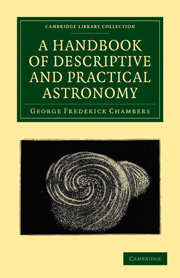Book contents
- Frontmatter
- PREFACE
- SUPPLEMENT
- Contents
- LIST OF ILLUSTRATIONS
- PRINCIPAL AUTHORITIES
- Errata
- A Handbook of Descriptive and Practical Astronomy
- BOOK I A SKETCH OF THE SOLAR SYSTEM
- CHAPTER I THE SUN
- CHAPTER II THE PLANETS
- CHAPTER III VULCAN
- CHAPTER IV MERCURY
- CHAPTER V VENUS
- CHAPTER VI THE EARTH
- CHAPTER VII THE MOON
- CHAPTER VIII MARS
- CHAPTER IX THE MINOR PLANETS
- CHAPTER X JUPITER
- CHAPTER XI SATURN
- CHAPTER XII URANUS
- CHAPTER XIII NEPTUNE
- BOOK II ECLIPSES AND THEIR ASSOCIATED PHENOMENA
- BOOK X METEORIC ASTRONOMY
- APPENDICES
- INDEX TO SUBJECTS
- INDEX TO NAMES
- Plate section
CHAPTER VI - THE EARTH
Published online by Cambridge University Press: 05 July 2011
- Frontmatter
- PREFACE
- SUPPLEMENT
- Contents
- LIST OF ILLUSTRATIONS
- PRINCIPAL AUTHORITIES
- Errata
- A Handbook of Descriptive and Practical Astronomy
- BOOK I A SKETCH OF THE SOLAR SYSTEM
- CHAPTER I THE SUN
- CHAPTER II THE PLANETS
- CHAPTER III VULCAN
- CHAPTER IV MERCURY
- CHAPTER V VENUS
- CHAPTER VI THE EARTH
- CHAPTER VII THE MOON
- CHAPTER VIII MARS
- CHAPTER IX THE MINOR PLANETS
- CHAPTER X JUPITER
- CHAPTER XI SATURN
- CHAPTER XII URANUS
- CHAPTER XIII NEPTUNE
- BOOK II ECLIPSES AND THEIR ASSOCIATED PHENOMENA
- BOOK X METEORIC ASTRONOMY
- APPENDICES
- INDEX TO SUBJECTS
- INDEX TO NAMES
- Plate section
Summary
The form of the Earth is not strictly spherical, the polar diameter being less than the equatorial by about 26½ miles; it is, in fact, like many, probably all, the planets, an oblate spheroid. The great circle of the heavens apparently described by the Sun every year, owing to our revolution round that body, is called the ecliptic, and is usually employed by astronomers as a fixed plane of reference. The Earth's equator prolonged in the direction of the fixed stars, differs from the equator of the heavens, which is inclined to the plane of the ecliptic at an angle which in January 1, 1860, was equal to 23° 27′ 33″ and which angle is known as the obliquity of the ecliptic. It is this inclination which gives rise to the vicissitudes of the seasons during our annual revolution round the Sun. The two points where the celestial equator is intersected by the ecliptic, are called the equinoxes; the points exactly midway between these being the solstices. It is from the vernal (or spring) equinox, that right ascensions are measured along the equator and longitudes along the ecliptic.
- Type
- Chapter
- Information
- A Handbook of Descriptive and Practical Astronomy , pp. 37 - 40Publisher: Cambridge University PressPrint publication year: 2010First published in: 1861

